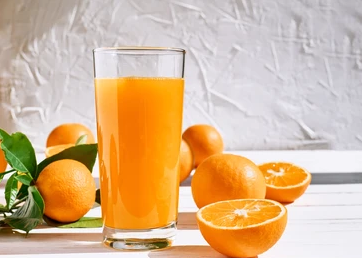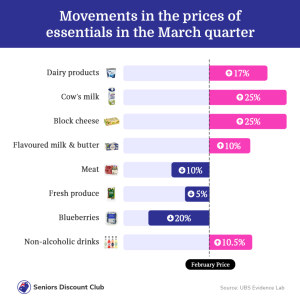The shocking reason why your orange juice prices are about to skyrocket - Are supply shortages to blame?
By
- Replies 16
Orange juice is a greatly appreciated source of vitamin C, hydration, and sweetness, with more and more people relying on a glass of juice to start their day off right.
But unfortunately, if you are an avid orange juice drinker, you may need to brace yourself for a bit of 'checkout pain' as it looks like the prices of orange juice are set to soar in the coming months.
New data by Dutch banking firm Rabobank has revealed that the supply of oranges has been affected due to two consecutive small harvests, therefore setting buyers up for a grim 2023 season.
Rabobank senior analyst Andrés Padilla said: 'We see very low inventories from two consecutive small harvests … plus worsening news for the current season.’
'This created the perfect environment for orange juice prices to see a significant rally this year, surpassing levels last seen back in 2017 and climbing towards all-time highs.'

Just how much will this affect us here Down Under?
Australia’s orange supply is obtained from domestic and foreign sources, with Brazil being the primary supplier for most countries.
However, unlike other foreign brands, Australian orange juice brands are less likely to face significant repercussions as half of their orange supply still comes from local Australian farmers.
‘The challenging weather conditions that growers have encountered (in Australia) in the past year … would have impacted production and be feeding into higher prices,’ said Rabobank associate analyst Pia Piggott.
How much of a price increase can we expect?
While there is no specific tracking of the average price of orange juice in Australia, quarterly consumer price index data shows that non-alcoholic beverages have increased by 10.5 per cent in the year leading up to December 2022.
Currently, the average price of orange juice at Woolworths and Coles supermarkets is around $5.50, depending on the size and brand of the bottle.
However, there is some good news for consumers, as weaker demand and a hopefully more successful 2023-2024 season are expected to bring prices down to a moderate level.
Looking ahead, the hope is that a couple of substantial harvests will restore balance to the market and bring orange prices to a more ‘neutral’ position in the long term.
Food prices have risen sharply across essential categories, according to new data from UBS Evidence Lab, contributing to higher grocery bills.
The data, which tracks weekly prices in Australian supermarkets for dairy products, spreads, meat, fruit, and vegetables, revealed a 10 per cent increase in food inflation in the March quarter.
Dairy prices rose by 17 per cent, with cow's milk prices up by 25 per cent. Block cheese prices also climbed by almost 25 per cent, and prices for flavoured milk and butter increased by over 10 per cent.
Meat prices rose by 10 per cent but are now starting to fall, with chicken, pork, and beef prices slightly cheaper in March than in February.
In fresh produce, fruit and vegetable costs fell by 5 per cent, with blueberries seeing the sharpest decline in prices at 20 per cent.
Bread prices were not included in the data, but bakery Tip Top has raised its prices due to rising production and supply chain costs.
Customers are becoming increasingly aware that $50 doesn't buy the same quantity or quality of supermarket products as it once did.

Remember to always be vigilant when checking food prices and take advantage of the great offers and discounts we share here at the Seniors Discount Club.
Do you have any tips and tricks for keeping your grocery prices down? Maybe you have a favourite budget orange juice recommendation. Share your advice and experience in the comments section below!
But unfortunately, if you are an avid orange juice drinker, you may need to brace yourself for a bit of 'checkout pain' as it looks like the prices of orange juice are set to soar in the coming months.
New data by Dutch banking firm Rabobank has revealed that the supply of oranges has been affected due to two consecutive small harvests, therefore setting buyers up for a grim 2023 season.
Rabobank senior analyst Andrés Padilla said: 'We see very low inventories from two consecutive small harvests … plus worsening news for the current season.’
'This created the perfect environment for orange juice prices to see a significant rally this year, surpassing levels last seen back in 2017 and climbing towards all-time highs.'

Orange shortages are occurring globally, which may be causing orange juice prices to rise further. Credit: Shutterstock.
Just how much will this affect us here Down Under?
Australia’s orange supply is obtained from domestic and foreign sources, with Brazil being the primary supplier for most countries.
However, unlike other foreign brands, Australian orange juice brands are less likely to face significant repercussions as half of their orange supply still comes from local Australian farmers.
‘The challenging weather conditions that growers have encountered (in Australia) in the past year … would have impacted production and be feeding into higher prices,’ said Rabobank associate analyst Pia Piggott.
How much of a price increase can we expect?
While there is no specific tracking of the average price of orange juice in Australia, quarterly consumer price index data shows that non-alcoholic beverages have increased by 10.5 per cent in the year leading up to December 2022.
Currently, the average price of orange juice at Woolworths and Coles supermarkets is around $5.50, depending on the size and brand of the bottle.
However, there is some good news for consumers, as weaker demand and a hopefully more successful 2023-2024 season are expected to bring prices down to a moderate level.
Looking ahead, the hope is that a couple of substantial harvests will restore balance to the market and bring orange prices to a more ‘neutral’ position in the long term.
Food prices have risen sharply across essential categories, according to new data from UBS Evidence Lab, contributing to higher grocery bills.
The data, which tracks weekly prices in Australian supermarkets for dairy products, spreads, meat, fruit, and vegetables, revealed a 10 per cent increase in food inflation in the March quarter.
Dairy prices rose by 17 per cent, with cow's milk prices up by 25 per cent. Block cheese prices also climbed by almost 25 per cent, and prices for flavoured milk and butter increased by over 10 per cent.
Meat prices rose by 10 per cent but are now starting to fall, with chicken, pork, and beef prices slightly cheaper in March than in February.
In fresh produce, fruit and vegetable costs fell by 5 per cent, with blueberries seeing the sharpest decline in prices at 20 per cent.
Bread prices were not included in the data, but bakery Tip Top has raised its prices due to rising production and supply chain costs.
Customers are becoming increasingly aware that $50 doesn't buy the same quantity or quality of supermarket products as it once did.
Key Takeaways
- Orange juice prices are expected to rise due to supply shortages caused by consecutive small harvests.
- The price increase may not significantly affect Australian orange juice brands, as half of their supply comes from local farmers.
- There is no specific data on the average price of orange juice in Australia, but non-alcoholic beverages have experienced a 10.5 per cent price increase in the past year.
- Weaker demand and a more successful 2023-2024 season could bring prices down to a moderate level, and the hope is that a couple of substantial harvests will restore balance to the market.
Remember to always be vigilant when checking food prices and take advantage of the great offers and discounts we share here at the Seniors Discount Club.
Do you have any tips and tricks for keeping your grocery prices down? Maybe you have a favourite budget orange juice recommendation. Share your advice and experience in the comments section below!








